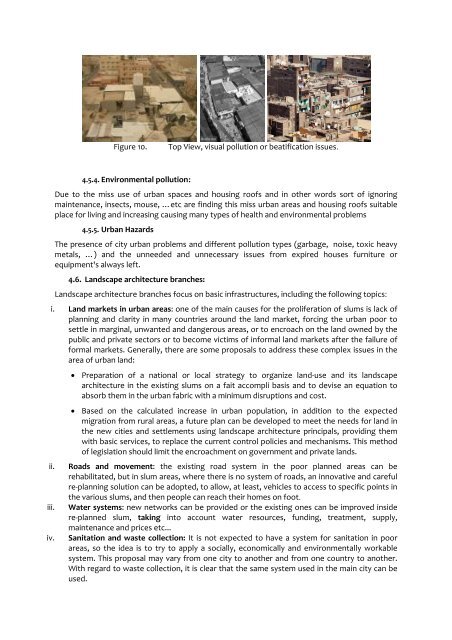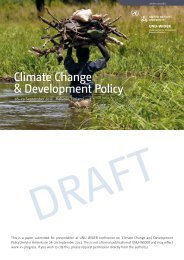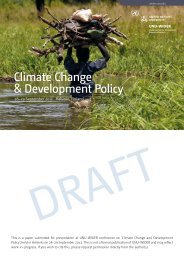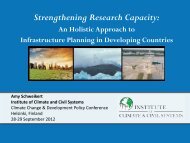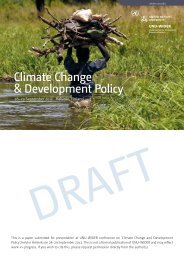Landscape architecture role in mitigating negative ... - UNU-WIDER
Landscape architecture role in mitigating negative ... - UNU-WIDER
Landscape architecture role in mitigating negative ... - UNU-WIDER
Create successful ePaper yourself
Turn your PDF publications into a flip-book with our unique Google optimized e-Paper software.
Figure 10.<br />
Top View, visual pollution or beatification issues.<br />
4.5.4. Environmental pollution:<br />
Due to the miss use of urban spaces and hous<strong>in</strong>g roofs and <strong>in</strong> other words sort of ignor<strong>in</strong>g<br />
ma<strong>in</strong>tenance, <strong>in</strong>sects, mouse, …etc are f<strong>in</strong>d<strong>in</strong>g this miss urban areas and hous<strong>in</strong>g roofs suitable<br />
place for liv<strong>in</strong>g and <strong>in</strong>creas<strong>in</strong>g caus<strong>in</strong>g many types of health and environmental problems<br />
4.5.5. Urban Hazards<br />
The presence of city urban problems and different pollution types (garbage, noise, toxic heavy<br />
metals, …) and the unneeded and unnecessary issues from expired houses furniture or<br />
equipment's always left.<br />
4.6. <strong>Landscape</strong> <strong>architecture</strong> branches:<br />
<strong>Landscape</strong> <strong>architecture</strong> branches focus on basic <strong>in</strong>frastructures, <strong>in</strong>clud<strong>in</strong>g the follow<strong>in</strong>g topics:<br />
i. Land markets <strong>in</strong> urban areas: one of the ma<strong>in</strong> causes for the proliferation of slums is lack of<br />
plann<strong>in</strong>g and clarity <strong>in</strong> many countries around the land market, forc<strong>in</strong>g the urban poor to<br />
settle <strong>in</strong> marg<strong>in</strong>al, unwanted and dangerous areas, or to encroach on the land owned by the<br />
public and private sectors or to become victims of <strong>in</strong>formal land markets after the failure of<br />
formal markets. Generally, there are some proposals to address these complex issues <strong>in</strong> the<br />
area of urban land:<br />
ii.<br />
iii.<br />
iv.<br />
• Preparation of a national or local strategy to organize land‐use and its landscape<br />
<strong>architecture</strong> <strong>in</strong> the exist<strong>in</strong>g slums on a fait accompli basis and to devise an equation to<br />
absorb them <strong>in</strong> the urban fabric with a m<strong>in</strong>imum disruptions and cost.<br />
• Based on the calculated <strong>in</strong>crease <strong>in</strong> urban population, <strong>in</strong> addition to the expected<br />
migration from rural areas, a future plan can be developed to meet the needs for land <strong>in</strong><br />
the new cities and settlements us<strong>in</strong>g landscape <strong>architecture</strong> pr<strong>in</strong>cipals, provid<strong>in</strong>g them<br />
with basic services, to replace the current control policies and mechanisms. This method<br />
of legislation should limit the encroachment on government and private lands.<br />
Roads and movement: the exist<strong>in</strong>g road system <strong>in</strong> the poor planned areas can be<br />
rehabilitated, but <strong>in</strong> slum areas, where there is no system of roads, an <strong>in</strong>novative and careful<br />
re‐plann<strong>in</strong>g solution can be adopted, to allow, at least, vehicles to access to specific po<strong>in</strong>ts <strong>in</strong><br />
the various slums, and then people can reach their homes on foot.<br />
Water systems: new networks can be provided or the exist<strong>in</strong>g ones can be improved <strong>in</strong>side<br />
re‐planned slum, tak<strong>in</strong>g <strong>in</strong>to account water resources, fund<strong>in</strong>g, treatment, supply,<br />
ma<strong>in</strong>tenance and prices etc...<br />
Sanitation and waste collection: It is not expected to have a system for sanitation <strong>in</strong> poor<br />
areas, so the idea is to try to apply a socially, economically and environmentally workable<br />
system. This proposal may vary from one city to another and from one country to another.<br />
With regard to waste collection, it is clear that the same system used <strong>in</strong> the ma<strong>in</strong> city can be<br />
used.


